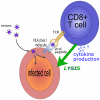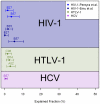The efficiency of the human CD8+ T cell response: how should we quantify it, what determines it, and does it matter?
- PMID: 22383867
- PMCID: PMC3285570
- DOI: 10.1371/journal.pcbi.1002381
The efficiency of the human CD8+ T cell response: how should we quantify it, what determines it, and does it matter?
Abstract
Multidisciplinary techniques, in particular the combination of theoretical and experimental immunology, can address questions about human immunity that cannot be answered by other means. From the turnover of virus-infected cells in vivo, to rates of thymic production and HLA class I epitope prediction, theoretical techniques provide a unique insight to supplement experimental approaches. Here we present our opinion, with examples, of some of the ways in which mathematics has contributed in our field of interest: the efficiency of the human CD8+ T cell response to persistent viruses.
Conflict of interest statement
The authors have declared that no competing interests exist.
Figures



Similar articles
-
In silico analysis of MHC-I restricted epitopes of Chikungunya virus proteins: Implication in understanding anti-CHIKV CD8(+) T cell response and advancement of epitope based immunotherapy for CHIKV infection.Infect Genet Evol. 2015 Apr;31:118-26. doi: 10.1016/j.meegid.2015.01.017. Epub 2015 Jan 31. Infect Genet Evol. 2015. PMID: 25643869
-
Determination of a T cell receptor of potent CD8+ T cells against simian immunodeficiency virus infection in Burmese rhesus macaques.Biochem Biophys Res Commun. 2020 Jan 22;521(4):894-899. doi: 10.1016/j.bbrc.2019.10.196. Epub 2019 Nov 9. Biochem Biophys Res Commun. 2020. PMID: 31711644
-
Overlapping CD8+ and CD4+ T-cell epitopes identification for the progression of epitope-based peptide vaccine from nucleocapsid and glycoprotein of emerging Rift Valley fever virus using immunoinformatics approach.Infect Genet Evol. 2017 Dec;56:75-91. doi: 10.1016/j.meegid.2017.10.022. Epub 2017 Nov 1. Infect Genet Evol. 2017. PMID: 29107145 Free PMC article.
-
[MHC tetramers: tracking specific immunity].Acta Med Croatica. 2003;57(4):255-9. Acta Med Croatica. 2003. PMID: 14639858 Review. Croatian.
-
Characteristics of HLA-E Restricted T-Cell Responses and Their Role in Infectious Diseases.J Immunol Res. 2016;2016:2695396. doi: 10.1155/2016/2695396. Epub 2016 Sep 6. J Immunol Res. 2016. PMID: 27699181 Free PMC article. Review.
Cited by
-
Evaluation of CD8 T cell killing models with computer simulations of 2-photon imaging experiments.PLoS Comput Biol. 2020 Dec 28;16(12):e1008428. doi: 10.1371/journal.pcbi.1008428. eCollection 2020 Dec. PLoS Comput Biol. 2020. PMID: 33370254 Free PMC article.
-
Antiviral capacity of the early CD8 T-cell response is predictive of natural control of SIV infection: Learning in vivo dynamics using ex vivo data.PLoS Comput Biol. 2024 Sep 10;20(9):e1012434. doi: 10.1371/journal.pcbi.1012434. eCollection 2024 Sep. PLoS Comput Biol. 2024. PMID: 39255323 Free PMC article.
-
In Vivo Killing Capacity of Cytotoxic T Cells Is Limited and Involves Dynamic Interactions and T Cell Cooperativity.Immunity. 2016 Feb 16;44(2):233-45. doi: 10.1016/j.immuni.2016.01.010. Epub 2016 Feb 9. Immunity. 2016. PMID: 26872694 Free PMC article.
-
Notwithstanding Circumstantial Alibis, Cytotoxic T Cells Can Be Major Killers of HIV-1-Infected Cells.J Virol. 2016 Jul 27;90(16):7066-7083. doi: 10.1128/JVI.00306-16. Print 2016 Aug 15. J Virol. 2016. PMID: 27226367 Free PMC article.
-
Mechanistic basis of post-treatment control of SIV after anti-α4β7 antibody therapy.PLoS Comput Biol. 2021 Jun 9;17(6):e1009031. doi: 10.1371/journal.pcbi.1009031. eCollection 2021 Jun. PLoS Comput Biol. 2021. PMID: 34106916 Free PMC article.
References
-
- Gea-Banacloche JC, Migueles SA, Martino L, Shupert WL, McNeil AC, et al. Maintenance of large numbers of virus-specific CD8+ T cells in HIV-infected progressors and long-term nonprogressors. J Immunol. 2000;165:1082–1092. - PubMed
-
- Boyd MA, Dixit NM, Siangphoe U, Buss NE, Salgo MP, et al. Viral decay dynamics in HIV-infected patients receiving ritonavir-boosted saquinavir and efavirenz with or without enfuvirtide: a randomized, controlled trial (HIV-NAT 012). J Infect Dis. 2006;194:1319–1322. - PubMed
Publication types
MeSH terms
Substances
Grants and funding
LinkOut - more resources
Full Text Sources
Research Materials

